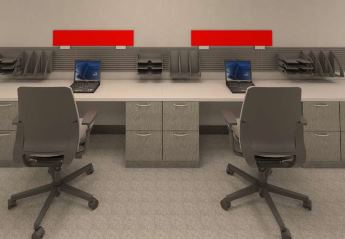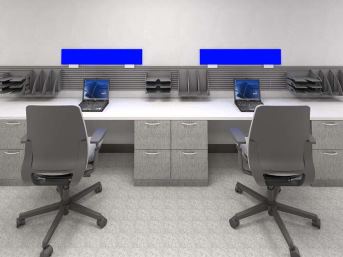
Understanding Rotating Shift Workers' Health Risks
Until we know more, it is recommended that lighting in health care facilities should be designed to minimize acute melatonin suppression in night shift workers.
- By Mariana G. Figueiro, Claudia M. Hunter
- Nov 01, 2016
Health care facilities cannot function without personnel who are willing to work evening and overnight shifts. Yet evidence is mounting that shift work may be detrimental to workers’ health. In 2007, the International Agency for Research in Cancer (IARC) declared that shift work involving circadian disruption is a probable carcinogen, citing robust evidence from animal studies while also noting that more evidence from human studies was needed. Indeed, studies conducted on animals have strongly suggested that circadian disruption is associated with faster tumor growth rates. Meanwhile, accumulating data from epidemiologic studies of humans suggest probable links between people who work rotating night shifts for 20-30 years and increased risk for cancer, most notably breast cancer in females and prostate cancer in males.
Why Are Rotating Shift Workers at Higher Risk for Diseases?
The potential for rotating shift worker health risk falls into two general categories. One category relates to circadian disruption resulting from irregular sleep-wake cycles, and the second relates to acute melatonin suppression by exposure to light at night.
Each of us has a "biological clock" in our brain that generates and regulates our circadian rhythms. Circadian rhythms are biological processes that repeat about every 24 hours, such as the sleep-wake cycle and the production of hormones. Light-dark patterns reaching the back of our eyes reset the timing of the biological clock on a daily basis and ensure that we are in synchrony with our local time on Earth. Circadian disruption occurs when the brain’s biological clock is not in synchrony with external time and with other parts of our body. Simply put, circadian disruption occurs when the body does not "do the right thing at the right time."
 Circadian disruption can affect the timing of sleep, patterns and amplitude of hormone production, and even cell regeneration, leading to declines in performance, sleep quality, and health. In fact, animal studies clearly show that placing animals on a rotating light-dark schedule leads to higher incidences of cancer, cardiovascular disease, diabetes, and obesity. Given that rotating shift workers are more likely to suffer from circadian disruption because of the misalignment between their sleep-wake cycle and their light-dark exposure, it is reasonable to assume that the findings from animal studies can potentially help to explain the data gathered from epidemiological studies of human populations.
Circadian disruption can affect the timing of sleep, patterns and amplitude of hormone production, and even cell regeneration, leading to declines in performance, sleep quality, and health. In fact, animal studies clearly show that placing animals on a rotating light-dark schedule leads to higher incidences of cancer, cardiovascular disease, diabetes, and obesity. Given that rotating shift workers are more likely to suffer from circadian disruption because of the misalignment between their sleep-wake cycle and their light-dark exposure, it is reasonable to assume that the findings from animal studies can potentially help to explain the data gathered from epidemiological studies of human populations.
In addition to suffering from circadian disruption, rotating shift workers may also be more susceptible to experiencing acute melatonin suppression resulting from exposure to light at night. Melatonin is a hormone we produce at night and in darkness, and it is known as the "darkness" hormone because it signals nighttime to the body. Animal studies have shown that melatonin plays an anti-cancer role and reduces the growth rate of tumors. A few studies also suggest that while the amount of light shift workers are exposed to during work may not be enough to acutely suppress their melatonin production, their total melatonin levels over the course of 24 hours are nonetheless reduced compared to dayshift workers. This overall reduction in the amplitude of melatonin levels noted for rotating shift workers may be a result of circadian disruption resulting from staying awake at night.
What Kind of Light Suppresses Melatonin?
 The potentially disrupting effects of light at night depend on the balance established between the light’s color, the light's level, and both the timing and duration of exposure to that light. Generally speaking, for exposures at the eye to light of similar levels and duration, light sources in the warmer, long-wavelength range of the spectrum (Figure 1, above) are less effective at suppressing melatonin than light sources in the cooler, short-wavelength range of the spectrum (Figure 2 at left). Published studies indicate that exposure at the eye to at least 20-30 lux of a warm color light source for at least 30 minutes is needed to suppress melatonin. It should be noted, however, that we do not yet know enough about the specific lighting characteristics that can induce circadian disruption, although it has been established that disruption of the melatonin cycle can lead to circadian disruption. Until we know more, it is recommended that lighting in health care facilities should be designed to minimize acute melatonin suppression in night shift workers.
The potentially disrupting effects of light at night depend on the balance established between the light’s color, the light's level, and both the timing and duration of exposure to that light. Generally speaking, for exposures at the eye to light of similar levels and duration, light sources in the warmer, long-wavelength range of the spectrum (Figure 1, above) are less effective at suppressing melatonin than light sources in the cooler, short-wavelength range of the spectrum (Figure 2 at left). Published studies indicate that exposure at the eye to at least 20-30 lux of a warm color light source for at least 30 minutes is needed to suppress melatonin. It should be noted, however, that we do not yet know enough about the specific lighting characteristics that can induce circadian disruption, although it has been established that disruption of the melatonin cycle can lead to circadian disruption. Until we know more, it is recommended that lighting in health care facilities should be designed to minimize acute melatonin suppression in night shift workers.
What Can Health Care Professionals and Facility Managers Do Now?
Exposure to a regular 24-hour light-dark pattern is essential for circadian entrainment. Thus, to enhance sleep, performance, and well-being, day shift professional staff should:
- Receive high levels of illumination during the day (at least 200-300 lux at the cornea from a white light source), particularly during the morning after awakening.
- Sit by a window to receive daylight for at least 30 minutes in the morning.
- Minimize bright light (> 20-30 lux at the eye) during the evening (at least 2 hours prior to desired bedtimes) and at night.
- Turn off or dim luminous tablet computers in the evening.
- Avoid staying outdoors and receiving too much daylight during summer evenings or, alternatively, wear orange-tinted eyeglasses that filter out all light below 525 nanometers.
The situation is more complicated for night shift personnel. Generally, night shift professional staff are entrained to a day shift lifestyle because they still follow many daytime social activities, such as supporting their children's school schedules, conducting commerce, and engaging in recreational activities. For those reasons, among others, attempting to shift staff who work nights to a nocturnal lifestyle can be both personally impractical and undesirable. For night shift professionals who want to remain entrained to the day shift lifestyle but still be alert during the night shift, they should:
- Minimize bright light (> 20-30 lux at the eye) during the night shift, starting at around 9 p.m.
- Receive saturated red (640 nm) light of at least 40-60 lux at the eye in rest areas or workspaces during the dim-light period. Exposure to red light can be used intermittently throughout the night, similar to taking a coffee break. Red light exposure will not affect melatonin levels but will provide an alerting stimulus similar to a cup of coffee.
- Use task lights to increase light levels on the workplane and for specific, critical tasks, such as insertion of an IV.
- Take public transportation and do not drive home themselves in order to avoid falling asleep behind the wheel.
Another alternative for night shift workers is a "compromise solution" involving the use of light in the earlier part of the night to delay the point when workers become the sleepiest until after their shift is over, while also keeping that point near the end of sleep periods when the workers are off night shifts. In other words, the night shift professional would still be entrained to a day shift lifestyle, but he/she would now be a “night owl.” This compromise adaptation lets workers more easily switch between night and day shifts. To implement the compromise solution, night shift professionals should:
- Receive high levels of illumination until 3-4 a.m. (at least 200-300 lux at the cornea of a white light source) in workspaces followed by dim white light (20-30 lux at the eye) until the end of the working shift.
- Receive saturated red (640 nm) light of at least 40-60 lux at the eye in rest areas or at workspaces during the dim light period. Exposure to red lights can be used intermittently throughout the night, similar to taking a coffee break.
- Use task lights to increase light levels on the workplane and for specific, critical tasks, such as insertion of an IV.
- Wear dark sunglasses on the way home after work to prevent outdoor light from affecting their night owl adaptation.
- Take public transportation and do not drive home themselves in order to avoid falling asleep behind the wheel.
Some of these lighting solutions have been tested under controlled laboratory conditions but have yet to be tested in the field. Currently, the Lighting Research Center laboratory, under a grant from the National Institute for Occupational Safety and Health, is testing to determine whether red light can indeed help shift workers feel more alert at night without disrupting their circadian clock. Given that night shift workers can choose to follow either the compromise solution or retain a day shift schedule and simply expose themselves to red light at any time required during the night to provide alerting stimulus, it would be best to maintain the overall ambient light at low levels during night shifts and provide additional bright light via light goggles or task lighting around computer screens.
For now, it is recommended that a dynamic ambient lighting which changes in color and light level over the course of the day should be used to support the circadian system, along with dedicated task lighting for critical visual tasks. It is also important to keep lighting controls simple and intuitive; for example, for ambient lighting, a simple preset wall control labeled "Daytime," "Nighttime," and "Off" would suffice. New, more-precise lighting schemes can be implemented in health care facilities once more field tests of these potential lighting solutions have been completed.
This article originally appeared in the November 2016 issue of Occupational Health & Safety.